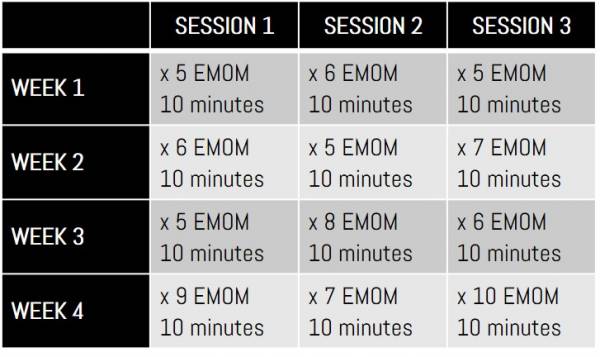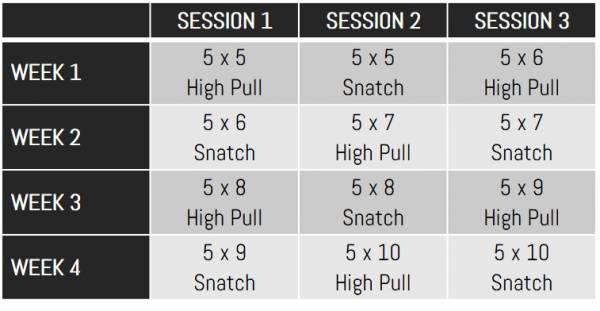You want to prepare for higher-level kettlebell skills so, the imperative is to maintain the essentials of the basic skills.
We are going to help you develop your foundational kettlebell skills here, and also prompt you to try some new skills.
If you feel like you want to go even further then you can jump into my 12-Week Turbo Charged workout challenge.
You want to prepare for higher-level kettlebell skills so, the imperative is to maintain the essentials of the basic skills.
We are going to help you develop your foundational kettlebell skills here, and also prompt you to try some new skills.
If you feel like you want to go even further then you can jump into my 12-Week Turbo Charged workout challenge.
Even if you feel like you know the material here remember, whenever workouts become stagnant, we often default to the mindset of needing heavier weights, more reps, more training frequency, or even setting aside working out altogether to try something new.
By shifting gears and focusing on skill development, we force our bodies into new adaptations and meet the inner need to become better and grow internally, which keeps us engaged in the process.
Before you start, feel free to use the following 5 minute warm up routine. I’ve designed this specifically for my programming.
Now, let’s dig into the skills we want to cover:
- Swings – To solidify your hip hinge movement pattern.
- Cleans – To direct your energy and gain control of the kettlebell.
- Presses – To build abdominal and shoulder stability and prep your body for what’s next.
- Turkish Get Ups – For total body awareness under tension as a precursor to the bent press.
- Snatches – For dynamic conditioning and a rock solid upper back.
- Squats – To build lower body strength and the integration between lats, abs, and glutes.
Try the following workout to practice the foundational skills:
10 rounds (5R/L):
- A1 – Swings x10
- A2 – Clean & Press x5
- A3 – Front Squat x5
5 rounds:
- B1 – Turkish Getup x1R/1L
- B2 – Snatches x10R/10L
The Double Kettlebell Swing
The double kettlebell swing is the basis of the entire turbo charged kettlebells approach. Performing the double kettlebell swing generates massive power through your hips, glutes, and legs. With an emphasis on the development of your hamstrings, glutes, and lower back, the double swing not only helps prevent injuries long term, but it also enables you to perform other lifts and athletic activities with greater ease by centering in on the core of athleticism.
- Begin in an athletic hip hinged position with one hand on each kettlebell. Look forward about 6 to 10 feet in front of you, or at the horizon line.
- Hike the kettlebells back between your legs using your lats. Then stand up explosively by squeezing your butt cheeks together hard to pull your hips forward.
- Stand strong at the top of the swing by grinding your feet through the ground, bracing your abs as if preparing to get punched in the gut, and pressing your shoulders down away from your ears to keep your body integrated as a complete unit.
- After a brief floating pause at the top, allow the kettlebells to begin to descend, then push your butt back to guide the kettlebells between your legs again, and repeat.
- Stay in control of the action at all times. Put the kettlebells in their place rather than allowing the kettlebells to pull you into a position, especially on the way down.
Like the other double kettlebell exercises, the double swing requires a wider stance than the single kettlebell movements. For this reason, you’ll need plenty of practice with two kettlebells before moving on to heavier weights. This adjusted stance will challenge your body in amazing new ways.
Progression Makes Perfect
To begin practicing precision in the double swing, start with sets of one rep. Hike the kettlebells back, stand up once, hike them back again, and then park them in front of you. For the first two weeks, perform double swings three days per week, just thirty reps each session, but one rep at a time. Work for precision and accuracy rather than volume.
After that, try out this introductory four-week progression using three sessions per week, still keeping your emphasis on the technique. Add this to the beginning of your current programming, using lighter kettlebells than you would normally use. For example, a strong male who has completed all the RKC or SFG requirements with a 24kg kettlebell would benefit from shifting to a pair of 16kg kettlebells in this progression.
Apply these introductory progressions slowly over time for long-term, sustainable impact. The program will take these basic progressions to the next level and integrate your skills with incredible strength and conditioning protocols.
The Double Clean
The double clean is one of the most effective stand-alone exercises, and it is a perfect complement to the double swing. It also serves as the primary transitional phase between most of the other kettlebell skills we are discussing here. At the top of the double clean, you will be in the double rack position. A solid double rack position will make or break your success in this series.
How to Double Clean
When the kettlebells are in the double rack position, you are essentially in a weighted standing plank. A proper double rack requires deliberate muscular engagement, rather than a passive hold. Actively squeeze your elbows into your sides as you draw your shoulders back. Keep a firm belly, stay tight, and continue to breathe through the tension. Pause briefly in each rep of the rack to solidify the position before moving on. Rushing though this pivotal transition and not respecting the pause before moving on to the next movement will bleed into everything else in the sequence, setting the stage for mediocre development and sloppy technique.
When performing the double clean, hike the kettlebells back between your legs from the rack position and then return to the rack with the same explosive hip extension that you used during the double swing. The two primary faults when performing the double clean are casting the kettlebells away from your body on the way down, and letting them drift too far away from you on the way up.
On the descent, let the kettlebells roll out of the rack, and then take control by shooting your hips back into the hinge position and stabilizing through your lats. On the way up, keep your elbows close to your body as you clean, but not rigidly attached to your ribs. When your double clean is crisp on your hip extension and smooth on the finish, you’ve taken a massive leap forward in your overall technique development.
Build Proficiency Slowly
To begin practicing precision in the double clean, start with sets of 1 rep: Hike the kettlebells back, stand up into the double rack position, pause, then hike them back and park them in front of you. For the first 2 weeks, perform double cleans 3 days per week, 30 reps each session, but 1 rep at a time. Work for precision and accuracy rather than volume.
After that, try this introductory 4-week progression using 3 sessions per week, still keeping your emphasis on the technique. Add this at the beginning of your current programming with lighter kettlebells than you would normally use. For example, a strong male who has completed all the RKC or SFG requirements with a 24kg kettlebell would benefit from shifting to a pair of 16kg kettlebells in this progression.
Until you can perform 100 reps of the double clean in 10 minutes at 10 reps per minute, there is no reason other than ego to step up to a heavier pair of kettlebells. In the context of this program where the priority is on skill development, the emphasis remains on performing each rep as perfectly as possible, even in the midst of fatigue.

Apply these introductory progressions slowly over time for long-term sustainable impact.
Double High Pull
If ever there was an exercise that spotlights upper back development, the double high pull is it. This exercise, when performed with precision and accuracy will transform your posture and increase your work capacity.
The bottom position is exactly the same as the swing and the clean, but the real magic lies in the top position and the transition. Getting there requires not only a solid hip drive, but also control of the power generated to guide the kettlebells up to shoulder level. You have to subtly shorten the arc of the kettlebell path by bending your elbows and intentionally drawing the kettlebells back before returning along the same path. It’s really less of a “pull” and more of a guided effort.
The descent of the double high pull demands an adaptive eccentric contraction, meaning that your muscles must lengthen while contracting in order to decelerate the kettlebells. This slight nuance makes the double high pull a top pick for Turbo Charged Kettlebells and beyond.
Double Snatch
After your double high pull is dialed in, it’s time begin pursuing the double snatch. The double snatch has many variations and different styles depending on what source you are looking to for information. The double snatch of the Turbo Charged Kettlebells program is composed of a double high pull that finishes overhead, with a pause at the lockout, followed by pulling the kettlebells back down into the rack position. The act of pulling the kettlebells back to the rack position before initiating the next rep is sometimes called a “half snatch.”
This style places less strain on the low back, keeping you free from injury as you accumulate volume over the course of the full 12-week program, and it forces you to emphasize good technique rather than slamming out as many reps as possible.
Hike two kettlebells back between your legs and stand up explosively into a double high pull. Instead of floating the kettlebells and then returning, punch both fists through as you aggressively rotate the handles around the main body of the kettlebells. Then decelerate the kettlebells into a double overhead position. Finish by pulling both kettlebells into the double rack position. From here, hike the kettlebells back again and repeat.
Let each phase of the exercise be a distinct and sharp movement all on its own. Review the demo video and the pictures often to solidify the positions in your mind, which will translate to smoother and sharper reps as you practice.
A Progression for Practice
Try the following 4-week progression, integrated into your regular workout, to practice the high pull and snatch. As I said previously, you can use this progression as preparation for the full 12-week program. Rest as much as needed between sets, focusing on precision.

Apply these introductory progressions slowly over time for long-term sustainable impact.
And to get an idea of where you can go with the Turbo Charged Kettlebells program here are 3 workout routines to give you a taste of how you can take your foundation skills and really challenge yourself in a big way.






